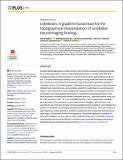LittleBrain: A gradient-based tool for the topographical interpretation of cerebellar neuroimaging findings
Author(s)
Schmahmann, Jeremy D.; Guell Paradis, Xavier; Goncalves, Mathias; Kaczmarzyk, Jakub; Gabrieli, John D. E.; Ghosh, Satrajit S; ... Show more Show less
Downloadjournal.pone.0210028.pdf (3.152Mb)
PUBLISHER_CC
Publisher with Creative Commons License
Creative Commons Attribution
Terms of use
Metadata
Show full item recordAbstract
Gradient-based approaches to brain function have recently unmasked fundamental properties of brain organization. Diffusion map embedding analysis of resting-state fMRI data revealed a primary-to-transmodal axis of cerebral cortical macroscale functional organization. The same method was recently used to analyze resting-state data within the cerebellum, revealing for the first time a sensorimotor-fugal macroscale organization principle of cerebellar function. Cerebellar gradient 1 extended from motor to non-motor task-unfocused (default-mode network) areas, and cerebellar gradient 2 isolated task-focused processing regions. Here we present a freely available and easily accessible tool that applies this new knowledge to the topographical interpretation of cerebellar neuroimaging findings. LittleBrain illustrates the relationship between cerebellar data (e.g., volumetric patient study clusters, task activation maps, etc.) and cerebellar gradients 1 and 2. Specifically, LittleBrain plots all voxels of the cerebellum in a two-dimensional scatterplot, with each axis corresponding to one of the two principal functional gradients of the cerebellum, and indicates the position of cerebellar neuroimaging data within these two dimensions. This novel method of data mapping provides alternative, gradual visualizations that complement discrete parcellation maps of cerebellar functional neuroanatomy. We present application examples to show that LittleBrain can also capture subtle, progressive aspects of cerebellar functional neuroanatomy that would be difficult to visualize using conventional mapping techniques. Download and use instructions can be found at https://xaviergp.github.io/littlebrain.
Date issued
2019-01Department
Harvard University--MIT Division of Health Sciences and Technology; Massachusetts Institute of Technology. Clinical Research Center; Massachusetts Institute of Technology. Department of Brain and Cognitive Sciences; Massachusetts Institute of Technology. Office of Digital Learning; Massachusetts Institute of Technology. Research Laboratory of Electronics; McGovern Institute for Brain Research at MITJournal
PLOS ONE
Publisher
Public Library of Science
Citation
Guell, Xavier, Mathias Goncalves, Jakub R. Kaczmarzyk, John D. E. Gabrieli, Jeremy D. Schmahmann, and Satrajit S. Ghosh. “LittleBrain: A Gradient-Based Tool for the Topographical Interpretation of Cerebellar Neuroimaging Findings.” Edited by Daniel S. Margulies. PLOS ONE 14, no. 1 (January 16, 2019):
Version: Final published version
ISSN
1932-6203